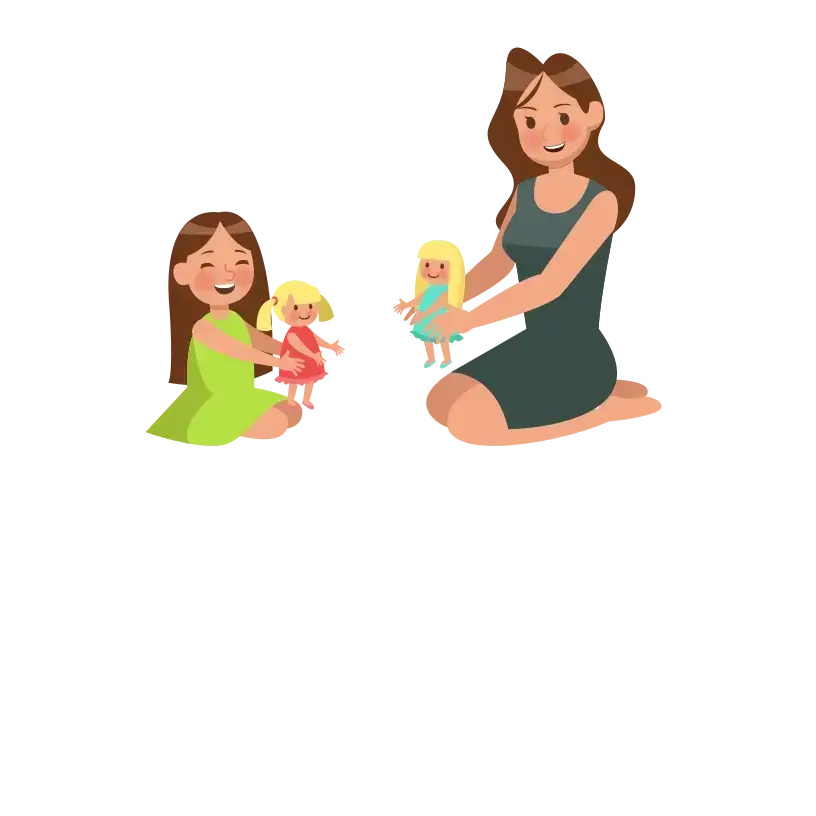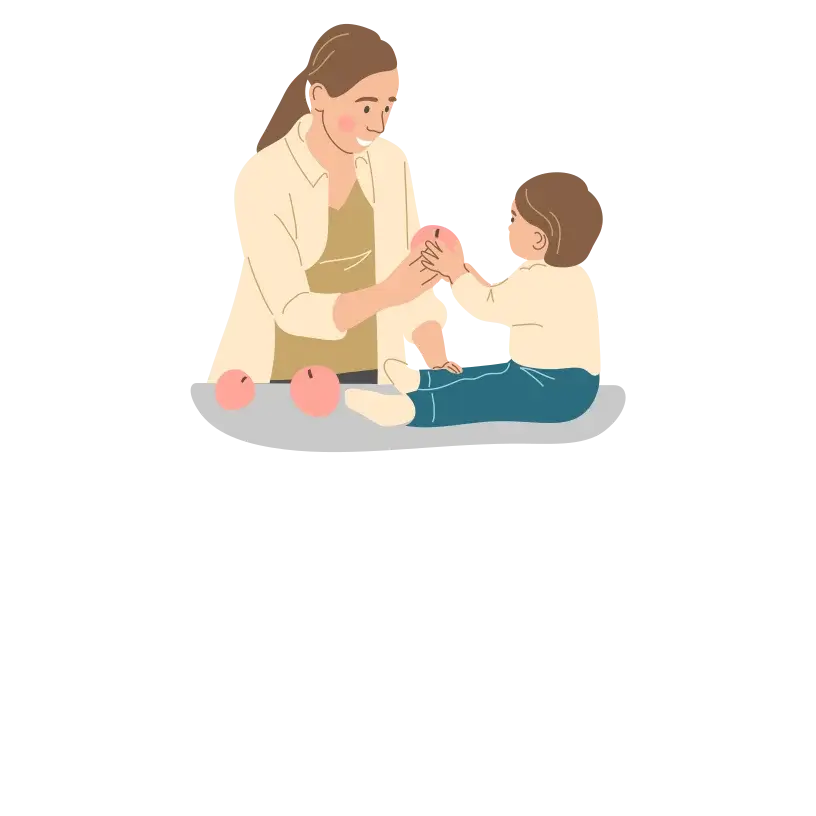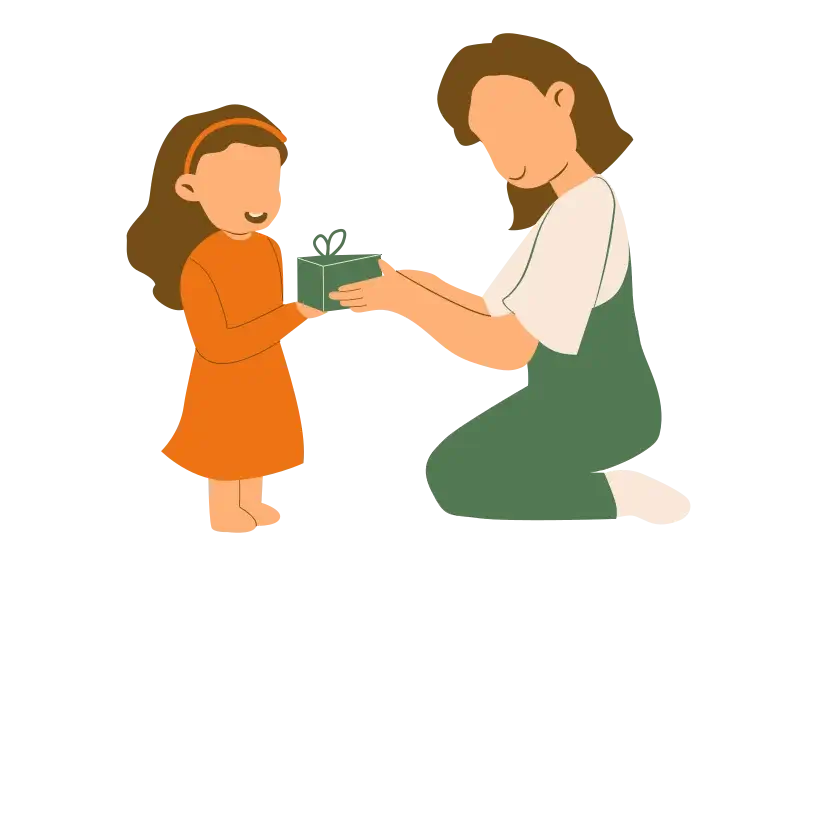Menu

Being a parent is a beautiful yet challenging journey. Children are like little sponges, absorbing everything around them. Sometimes, they test limits by spitting, hitting, throwing tantrums, breaking and making snarky remarks. While you may get frustrated and resort to punishments, it’s crucial to recognize that reacting negatively could unintentionally encourage these actions.
This article discusses the benefits of positive reinforcement and how to incorporate this strategy into your daily life to elevate your child’s behaviour, fostering a supportive and nurturing environment for their growth and development.
Positive reinforcement is a behavioural concept that involves encouraging good behaviour by rewarding it. When someone does something you want to see more of, you give them a positive reward, making it more likely they’ll repeat that behavior. It’s like saying, “Great job!” or offering a reward to reinforce positive actions.
For example, if your child cleans their room as requested, praising them or offering a small reward is positive reinforcement. The positive outcome makes it more probable that the child will continue tidying their room.
The key is associating positive consequences with desired behaviours, reinforcing a connection that motivates them to repeat those behaviours. This method is often more effective than focusing solely on correcting undesirable behaviours with punishments.
The type of positive reinforcement to adapt would depend on your child’s age and the behaviour you want to encourage or discourage. It’s like finding the right way to say “good job” or guide them when they misbehave.
You must choose the best approach based on their age and situation. Whether using words, rewards, spending time together, or physical actions like hugs, the key is matching positive reinforcement with your child’s needs. This helps create a positive environment, encourages good behaviour, and strengthens your connection with your child. The four types of positive reinforcement include:
Social reinforcement involves using positive social interactions as a reward for desired behaviour.
This approach includes expressions of praise, approval, or attention. For instance, when your child shares their toys, you might say, “Great job sharing your toys!” or offer a thumbs-up to express approval.
The reinforcement here is not a tangible item but rather the positive and encouraging words or gestures that reinforce your child’s good behaviour.
Social reinforcement acknowledges the specific action and fosters a positive emotional connection between you and your child. It emphasizes the importance of verbal and non-verbal cues in shaping behaviour and building a supportive and encouraging relationship.
Token reinforcement is a strategy that utilizes symbolic representations, such as stickers or points, as a reward.
The idea is that these tokens accumulate, and when a certain number is reached, they result in a more substantial reward. For instance, you might give your child a sticker for each completed task, like cleaning up their toys.
Once your child collects a specific number of stickers, they could be rewarded with something more significant, such as a small toy. This method provides a tangible and visual way for children to track their progress and work towards achieving a larger goal, making the reinforcement process both structured and motivating.
Natural reinforcement is like letting the good things that naturally happen because of a behaviour be the reward, without adding extra treats or toys. For example, if your child finishes their homework (that’s the behaviour), the natural reward is understanding the lesson and being ready for the next class. It’s like saying, “Well done!
You’ve learned something important and are now prepared for the next lesson.” This way, the positive outcome comes from the action, helping your child see the value in doing certain things without needing an extra reward.
Tangible reinforcement is a method where physical rewards or items are given to encourage desired behaviour. In simpler terms, it’s about offering something you can touch or enjoy in response to positive actions.
For instance, giving your child a small treat for cleaning up their toys or allowing them extra playtime as a reward for completing chores are examples of tangible reinforcement. These physical rewards make the positive behaviour more enjoyable and create a clear connection between the action and the positive outcome, motivating your child to repeat the desired behaviour in the future.
Social reinforcement involves using positive social interactions as a reward for desired behaviour. This approach includes expressions of praise, approval, or attention. For instance, when your child shares their toys, you might say, “Great job sharing your toys!” or offer a thumbs-up to express approval.
The reinforcement here is not a tangible item but rather the positive and encouraging words or gestures that reinforce your child’s good behaviour. Social reinforcement acknowledges the specific action and fosters a positive emotional connection between you and your child. It emphasizes the importance of verbal and non-verbal cues in shaping behaviour and building a supportive and encouraging relationship.
Token reinforcement is a strategy that utilizes symbolic representations, such as stickers or points, as a reward. The idea is that these tokens accumulate, and when a certain number is reached, they result in a more substantial reward.
For instance, you might give your child a sticker for each completed task, like cleaning up their toys. Once your child collects a specific number of stickers, they could be rewarded with something more significant, such as a small toy. This method provides a tangible and visual way for children to track their progress and work towards achieving a larger goal, making the reinforcement process both structured and motivating.
Natural reinforcement is like letting the good things that naturally happen because of a behaviour be the reward, without adding extra treats or toys.
For example, if your child finishes their homework (that’s the behaviour), the natural reward is understanding the lesson and being ready for the next class. It’s like saying, “Well done! You’ve learned something important and are now prepared for the next lesson.” This way, the positive outcome comes from the action, helping your child see the value in doing certain things without needing an extra reward.
Tangible reinforcement is a method where physical rewards or items are given to encourage desired behaviour. In simpler terms, it’s about offering something you can touch or enjoy in response to positive actions.
For instance, giving your child a small treat for cleaning up their toys or allowing them extra playtime as a reward for completing chores are examples of tangible reinforcement. These physical rewards make the positive behaviour more enjoyable and create a clear connection between the action and the positive outcome, motivating your child to repeat the desired behaviour in the future.
Positive reinforcement is a powerful tool in shaping behaviour, especially in parenting and child development.
You can create an environment that encourages positive behaviour by providing positive consequences for desired actions. Examples of positive reinforcement techniques and how they can be applied to reinforce good behaviour in your child include:

Positive reinforcement through verbal praise involves using encouraging words and acknowledging your child’s positive actions to reinforce and encourage those behaviours.
For example, if your child willingly shares their toys, you might say, “Great job! You’re such a good friend for sharing. That’s very kind of you!” Similarly, if they complete a task or chore, acknowledging their effort and achievement with phrases like “Fantastic job for cleaning up your toys!” or “You did a great job finishing your puzzle!” provides positive reinforcement.

Stickers or tokens serve as a tangible and visual method of positive reinforcement for children. Various positive behaviours are identified through a carefully designed sticker chart, and each is assigned a specific column or section.
When a child demonstrates one of these behaviours, they earn a sticker immediately. The sticker or token system encourages positive behaviour and visually represents a child’s achievements, fostering a sense of accomplishment and reinforcing a connection between actions and positive outcomes.

Granting special privileges is a parenting technique that involves offering extra benefits or choices to your child to reward positive behaviour. For instance, if your child is doing well with chores or showing good cooperation, you might extend their playtime as a special treat.
Another way is allowing them to choose an activity they enjoy, giving them a sense of control. Special privileges could include small treats or being first in line for something exciting.

Positive reinforcement through a favourite snack or treat is a delightful way to encourage good behaviour in toddlers.
When your child exhibits positive behaviour, like listening well during a shopping trip, you can immediately connect this behaviour with a special treat. By saying, “You listened so well at the store; let’s pick out a special treat together,” you acknowledge their good behaviour and involve them in decision-making. This collaborative approach empowers the child and reinforces a positive association between their actions and enjoyable outcomes.

Offering the chance to play with their favourite toy is a positive consequence for good behaviour. When your child demonstrates positive conduct, such as playing nicely with a sibling, it’s important to acknowledge this behaviour promptly. By saying, “Because you played nicely with your sibling,” you establish a direct connection between their positive actions and a rewarding outcome. Empowering the child to choose which game to play with their favourite toy adds an extra layer of significance to the reward, fostering a sense of autonomy.

Positive reinforcement through quality time involves rewarding your child for positive behaviour by engaging in an activity they enjoy together.
The key is to connect positive behaviour with a meaningful and enjoyable experience, reinforcing that behaving positively leads to special and enjoyable moments with the parent.
This approach strengthens the parent-child relationship and encourages the child to associate positive behaviour with positive and rewarding shared activities.

When your toddler does something good, you can show happiness and approval through physical actions. This could include giving them a high-five, clapping, cheering, or even a simple thumbs-up. Hugs, kisses, and pats on the back are great ways to express pride and affection. For example, after they tidy up, you might say, “Great job cleaning up!” while giving them a high-five. These physical gestures make them feel loved and appreciated and encourage them to keep up the positive behaviour. It’s a fun and effective way to reinforce good actions in a way that’s easy for toddlers to understand and enjoy.

Social recognition as a form of positive reinforcement involves praising your child in front of others or acknowledging their positive behaviour during social situations.
This public recognition highlights and celebrates the child’s achievements or good conduct. It not only boosts the child’s self-esteem by showcasing their positive qualities to others but also reinforces the idea that positive behaviour is valued and appreciated privately and within the social sphere.
This positive reinforcement technique contributes to the child’s sense of accomplishment and encourages the continuation of positive behaviour.

Positive reinforcement through verbal praise involves using encouraging words and acknowledging your child’s positive actions to reinforce and encourage those behaviours. For example, if your child willingly shares their toys, you might say, “Great job! You’re such a good friend for sharing.
That’s very kind of you!” Similarly, if they complete a task or chore, acknowledging their effort and achievement with phrases like “Fantastic job for cleaning up your toys!” or “You did a great job finishing your puzzle!” provides positive reinforcement.

Stickers or tokens serve as a tangible and visual method of positive reinforcement for children. Various positive behaviours are identified through a carefully designed sticker chart, and each is assigned a specific column or section.
When a child demonstrates one of these behaviours, they earn a sticker immediately. The sticker or token system encourages positive behaviour and visually represents a child’s achievements, fostering a sense of accomplishment and reinforcing a connection between actions and positive outcomes.

Granting special privileges is a parenting technique that involves offering extra benefits or choices to your child to reward positive behaviour. For instance, if your child is doing well with chores or showing good cooperation, you might extend their playtime as a special treat.
Another way is allowing them to choose an activity they enjoy, giving them a sense of control. Special privileges could include small treats or being first in line for something exciting.

Positive reinforcement through a favourite snack or treat is a delightful way to encourage good behaviour in toddlers. When your child exhibits positive behaviour, like listening well during a shopping trip, you can immediately connect this behaviour with a special treat.
By saying, “You listened so well at the store; let’s pick out a special treat together,” you acknowledge their good behaviour and involve them in decision-making. This collaborative approach empowers the child and reinforces a positive association between their actions and enjoyable outcomes.

Offering the chance to play with their favourite toy is a positive consequence for good behaviour. When your child demonstrates positive conduct, such as playing nicely with a sibling, it’s important to acknowledge this behaviour promptly.
By saying, “Because you played nicely with your sibling,” you establish a direct connection between their positive actions and a rewarding outcome. Empowering the child to choose which game to play with their favourite toy adds an extra layer of significance to the reward, fostering a sense of autonomy.

Positive reinforcement through quality time involves rewarding your child for positive behaviour by engaging in an activity they enjoy together. The key is to connect positive behaviour with a meaningful and enjoyable experience, reinforcing that behaving positively leads to special and enjoyable moments with the parent.
This approach strengthens the parent-child relationship and encourages the child to associate positive behaviour with positive and rewarding shared activities.

When your toddler does something good, you can show happiness and approval through physical actions. This could include giving them a high-five, clapping, cheering, or even a simple thumbs-up. Hugs, kisses, and pats on the back are great ways to express pride and affection.
For example, after they tidy up, you might say, “Great job cleaning up!” while giving them a high-five. These physical gestures make them feel loved and appreciated and encourage them to keep up the positive behaviour. It’s a fun and effective way to reinforce good actions in a way that’s easy for toddlers to understand and enjoy.

Social recognition as a form of positive reinforcement involves praising your child in front of others or acknowledging their positive behaviour during social situations. This public recognition highlights and celebrates the child’s achievements or good conduct.
It not only boosts the child’s self-esteem by showcasing their positive qualities to others but also reinforces the idea that positive behaviour is valued and appreciated privately and within the social sphere. This positive reinforcement technique contributes to the child’s sense of accomplishment and encourages the continuation of positive behaviour.
There are several positive behaviours you may want to reinforce to encourage your child’s development and create a positive environment. Some of the behaviours include:
Introducing positive reinforcement into children’s upbringing can profoundly benefit their development and the parent-child relationship.
This approach involves acknowledging and rewarding positive behaviours, creating a cycle that encourages your child to exhibit these behaviours more frequently. Beyond fostering good conduct, positive reinforcement builds your child’s self-esteem, promotes healthy communication, and strengthens the emotional bond between you and your child.

By offering positive attention or small rewards for behaviours like sharing or completing tasks, you create a cycle where your child learns that positive actions lead to enjoyable outcomes.
This positive reinforcement shapes their understanding of expected behaviours, fostering a sense of accomplishment and motivating them to repeat these positive actions in the future.

Regular positive reinforcement plays a crucial role in boosting your toddler’s confidence and self-esteem. When you consistently acknowledge and appreciate their positive actions, they feel recognized and valued. This positive feedback builds a strong sense of self-worth and confidence in your child, fostering a healthy foundation for their emotional development.

Incorporating positive reinforcement into your parenting fosters a strong and positive connection with your child. You create an environment of support and trust by consistently acknowledging and reinforcing their positive behaviours.
This positive interaction forms the basis of a nurturing relationship, enhancing the bond between you and your child. It establishes a foundation where your child feels valued and understood, contributing to a positive and trusting parent-child dynamic.

Giving your child verbal praise and positive attention is vital in enhancing their language development. When you communicate positively with your child, using encouraging words and attention, it contributes to the growth of their language skills.
This positive interaction creates a supportive environment for effective communication, helping your child build vocabulary, express themselves confidently, and develop essential language and communication abilities.

Linking positive outcomes, such as praise or rewards, to tasks like cleaning up or following instructions is a powerful tool for instilling a sense of responsibility in your child.
This association teaches your child that taking on responsibilities leads to positive results. This positive reinforcement helps shape their understanding of accountability and contributes to developing a responsible attitude, laying the groundwork for future tasks and obligations.

Applauding and rewarding independent actions through positive reinforcement nurtures a sense of autonomy in your child. When your child receives positive attention or rewards for doing things independently, it encourages them to take initiative in various tasks.
This positive cycle instils confidence and independence, empowering your child to explore and engage in activities autonomously. By reinforcing their independent efforts, you contribute to developing essential life skills and a proactive approach to learning and discovery.

Consistent positive reinforcement creates a positive and nurturing environment that significantly contributes to your child’s overall well-being. When your child experiences regular acknowledgement and rewards for positive behaviours, it establishes an atmosphere of encouragement and support.
This positivity fosters emotional well-being, confidence, and a sense of security, laying a foundation for healthy development. In such an environment, your child is more likely to thrive, feeling valued and motivated to engage positively with their surroundings and experiences.

Positive reinforcement is beneficial because it helps parents and teachers avoid the negative effects associated with harsh discipline. Unlike approaches that focus on punishment, positive reinforcement emphasizes encouraging and rewarding good behaviour.
This approach creates a more supportive and constructive environment, fostering positive relationships and minimizing the potential negative consequences of harsh disciplinary methods.

By offering positive attention or small rewards for behaviours like sharing or completing tasks, you create a cycle where your child learns that positive actions lead to enjoyable outcomes.
This positive reinforcement shapes their understanding of expected behaviours, fostering a sense of accomplishment and motivating them to repeat these positive actions in the future.

Regular positive reinforcement plays a crucial role in boosting your toddler’s confidence and self-esteem. When you consistently acknowledge and appreciate their positive actions, they feel recognized and valued.
This positive feedback builds a strong sense of self-worth and confidence in your child, fostering a healthy foundation for their emotional development.

Incorporating positive reinforcement into your parenting fosters a strong and positive connection with your child. You create an environment of support and trust by consistently acknowledging and reinforcing their positive behaviours.
This positive interaction forms the basis of a nurturing relationship, enhancing the bond between you and your child. It establishes a foundation where your child feels valued and understood, contributing to a positive and trusting parent-child dynamic.

Giving your child verbal praise and positive attention is vital in enhancing their language development.
When you communicate positively with your child, using encouraging words and attention, it contributes to the growth of their language skills.
This positive interaction creates a supportive environment for effective communication, helping your child build vocabulary, express themselves confidently, and develop essential language and communication abilities.

Linking positive outcomes, such as praise or rewards, to tasks like cleaning up or following instructions is a powerful tool for instilling a sense of responsibility in your child. This association teaches your child that taking on responsibilities leads to positive results.
This positive reinforcement helps shape their understanding of accountability and contributes to developing a responsible attitude, laying the groundwork for future tasks and obligations.

Applauding and rewarding independent actions through positive reinforcement nurtures a sense of autonomy in your child. When your child receives positive attention or rewards for doing things independently, it encourages them to take initiative in various tasks.
This positive cycle instils confidence and independence, empowering your child to explore and engage in activities autonomously. By reinforcing their independent efforts, you contribute to developing essential life skills and a proactive approach to learning and discovery.

Consistent positive reinforcement creates a positive and nurturing environment that significantly contributes to your child’s overall well-being. When your child experiences regular acknowledgement and rewards for positive behaviours, it establishes an atmosphere of encouragement and support.
This positivity fosters emotional well-being, confidence, and a sense of security, laying a foundation for healthy development. In such an environment, your child is more likely to thrive, feeling valued and motivated to engage positively with their surroundings and experiences.

Positive reinforcement is beneficial because it helps parents and teachers avoid the negative effects associated with harsh discipline. Unlike approaches that focus on punishment, positive reinforcement emphasizes encouraging and rewarding good behaviour.
This approach creates a more supportive and constructive environment, fostering positive relationships and minimizing the potential negative consequences of harsh disciplinary methods.
Adding positive reinforcement to your parenting approach can make a big difference for your child. Here are some practical tips to implement positive reinforcement and foster a positive and nurturing dynamic with your child.
Avoiding accidental positive reinforcement involves being mindful of your responses and ensuring you don’t unintentionally reinforce undesired behaviours. Here are some tips:
How you respond to your child’s actions is important. It means reacting similarly each time they do something.If there’s a behaviour you don’t like, being consistent ensures that your response is always the same.
For example, if your child whines and you consistently address it with a calm redirection, they learn that whining doesn’t get them what they want.
On the other hand, if your responses vary, it might accidentally reinforce the Behavior you want to discourage. Consistency helps set clear rules and helps your child understand what happens when they behave in a certain way, reducing confusion.
It’s important to tell your child exactly what behaviours you like and don’t.For instance, let them know if you want them to clean up their toys after playing.
When they do it, praise them for being positive. If they don’t, calmly guide them to the right behaviour. This clear communication helps your child know what you expect, making it easier for them to understand what’s good Behavior and what’s not.
It creates a more positive relationship between you and your child.
Being cautious not to reward undesired behaviours inadvertently ensures your reactions match those you want to encourage or discourage.
For instance, if your child is asking for attention in a disruptive way, like whining, giving in to their demands might unintentionally reinforce that behaviour.
Instead, responding in a way that discourages the undesired behaviour, like calmly redirecting them, is essential.
If your child is doing something you don’t want them to, like an undesired behaviour, redirect their attention to something more suitable.
The key is to avoid unintentionally encouraging the undesired behaviour by giving it attention. For example, if they’re being too loud, guide them toward a quieter activity.
By shifting their focus to a more appropriate task, you prevent them from associating the undesired behaviour with getting attention, helping to discourage it over time.
Pay attention to your non-verbal signals like facial expressions and body language. Make sure you’re not unintentionally encouraging behaviour through these cues.
For instance, if your child does something you don’t want to reinforce, like interrupting, avoid smiling or showing positive body language that might inadvertently encourage them.
Being mindful of your non-verbal cues helps ensure that your responses align with your intended guidance, consistently discouraging undesired behaviours.
Rather than accidentally encouraging behaviours you don’t want, focus on actively reinforcing positive alternatives.
Encourage and praise the behaviours you want to see, redirecting your child’s focus to positive actions. For example, if your child is being too rough with their toys, praise them when they handle them gently and appropriately.
This positive reinforcement helps guide your child toward your preferred behaviours, creating a more positive and encouraging environment.
When giving positive reinforcement, use descriptive praise to point out specific positive actions. Instead of just saying “good job,” provide details about what they did well.
For example, if your child shares a toy with a friend, say, “Great job sharing your toys and being kind to your friend.”
This specific feedback helps your child understand exactly what behaviour is being acknowledged, making it more meaningful and reinforcing positive actions effectively.
It’s important to ensure everyone caring for your child follows similar approaches when reinforcing behaviours. Consistency among caregivers and family members helps avoid accidentally encouraging behaviours you want to discourage.
For instance, if one caregiver responds to a certain behaviour with positive reinforcement and another with a different reaction, it can confuse the child.
How you respond to your child’s actions is important. It means reacting similarly each time they do something. If there’s a behaviour you don’t like, being consistent ensures that your response is always the same.
For example, if your child whines and you consistently address it with a calm redirection, they learn that whining doesn’t get them what they want. On the other hand, if your responses vary, it might accidentally reinforce the behavior you want to discourage. Consistency helps set clear rules and helps your child understand what happens when they behave in a certain way, reducing confusion.
It’s important to tell your child exactly what behaviours you like and don’t. For instance, let them know if you want them to clean up their toys after playing. When they do it, praise them for being positive. If they don’t, calmly guide them to the right behaviour.
This clear communication helps your child know what you expect, making it easier for them to understand what’s good behavior and what’s not. It creates a more positive relationship between you and your child.
Being cautious not to reward undesired behaviours inadvertently ensures your reactions match those you want to encourage or discourage. For instance, if your child is asking for attention in a disruptive way, like whining, giving in to their demands might unintentionally reinforce that behaviour.
Instead, responding in a way that discourages the undesired behaviour, like calmly redirecting them, is essential.
If your child is doing something you don’t want them to, like an undesired behaviour, redirect their attention to something more suitable. The key is to avoid unintentionally encouraging the undesired behaviour by giving it attention.
For example, if they’re being too loud, guide them toward a quieter activity. By shifting their focus to a more appropriate task, you prevent them from associating the undesired behaviour with getting attention, helping to discourage it over time.
Pay attention to your non-verbal signals like facial expressions and body language. Make sure you’re not unintentionally encouraging behaviour through these cues.
For instance, if your child does something you don’t want to reinforce, like interrupting, avoid smiling or showing positive body language that might inadvertently encourage them. Being mindful of your non-verbal cues helps ensure that your responses align with your intended guidance, consistently discouraging undesired behaviours.
Rather than accidentally encouraging behaviours you don’t want, focus on actively reinforcing positive alternatives. Encourage and praise the behaviours you want to see, redirecting your child’s focus to positive actions.
For example, if your child is being too rough with their toys, praise them when they handle them gently and appropriately. This positive reinforcement helps guide your child toward your preferred behaviours, creating a more positive and encouraging environment.
When giving positive reinforcement, use descriptive praise to point out specific positive actions. Instead of just saying “good job,” provide details about what they did well. For example, if your child shares a toy with a friend, say, “Great job sharing your toys and being kind to your friend.”
This specific feedback helps your child understand exactly what behaviour is being acknowledged, making it more meaningful and reinforcing positive actions effectively.
It’s important to ensure everyone caring for your child follows similar approaches when reinforcing behaviours. Consistency among caregivers and family members helps avoid accidentally encouraging behaviours you want to discourage.
For instance, if one caregiver responds to a certain behaviour with positive reinforcement and another with a different reaction, it can confuse the child.
Reward-based reinforcement is an alternative term for positive reinforcement. It encompasses the practice of offering rewards or positive stimuli to encourage and fortify desired behaviors.
It involves acknowledging and reinforcing positive actions through praise, approval, tangible rewards, or other positive consequences.
By associating these rewards with specific behaviors, toddlers are motivated to repeat those actions, reinforcing positive behavior patterns.
The principle of positive reinforcement is based on the idea that reinforcing or rewarding a behaviour immediately following its occurrence increases the likelihood that the behaviour will be repeated.
In other words, positive reinforcement involves providing a favourable consequence, such as praise, rewards, or privileges, to strengthen and encourage desired behaviours.
Positive reinforcement is a specific approach that involves encouraging good behaviours by rewarding them.
Behaviour therapy is a larger set of methods and techniques, and positive reinforcement is one of the strategies used within it.
So, positive reinforcement is a specific technique you might use when working with behaviour therapy, a broader approach to help positively modify behaviours.
The ABCs of positive reinforcement form a fundamental framework for understanding and modifying behaviours. The Antecedent, or what happens before a behaviour, sets the stage.
The Behavior, or the observable action, is what you want to reinforce. Finally, the Consequence, the outcome immediately following the behaviour, involves providing a positive stimulus to strengthen the likelihood of that Behavior occurring again.
This systematic approach allows individuals, parents, educators, or therapists to effectively identify, shape, and encourage positive behaviours by manipulating the factors surrounding the behaviour.
By recognizing the role of antecedents and consequences, positive reinforcement becomes a powerful tool for fostering desirable behaviours in various contexts.
The distinction between a bribe and positive reinforcement lies in the timing and intention.
A bribe typically involves offering something desirable before a behaviour, essentially trying to influence the child’s actions in advance (e.g., giving a toy upfront in exchange for good behaviour). On the other hand, positive reinforcement, or reinforcers, are provided after the child engages in appropriate behaviour.
This occurs planned and systematically to reinforce positive conduct and promote long-term behavioural change.
When picking rewards for your child, choosing things that match their age and what they enjoy is important.
Pay attention to what activities make them happy and who they like spending time with. Keep an eye on whether the chosen reward works well or if you need to try something new.
The key is to observe, listen, and adapt—ensuring the rewards are right for your child’s age and interests. This way, you create a positive environment that encourages good behaviour and makes your child feel motivated and supported.
Reward-based reinforcement is an alternative term for positive reinforcement. It encompasses the practice of offering rewards or positive stimuli to encourage and fortify desired behaviors. It involves acknowledging and reinforcing positive actions through praise, approval, tangible rewards, or other positive consequences.
By associating these rewards with specific behaviors, toddlers are motivated to repeat those actions, reinforcing positive behavior patterns.
The principle of positive reinforcement is based on the idea that reinforcing or rewarding a behaviour immediately following its occurrence increases the likelihood that the behaviour will be repeated.
In other words, positive reinforcement involves providing a favourable consequence, such as praise, rewards, or privileges, to strengthen and encourage desired behaviours.
Positive reinforcement is a specific approach that involves encouraging good behaviours by rewarding them.
Behaviour therapy is a larger set of methods and techniques, and positive reinforcement is one of the strategies used within it. So, positive reinforcement is a specific technique you might use when working with behaviour therapy, a broader approach to help positively modify behaviours.
The ABCs of positive reinforcement form a fundamental framework for understanding and modifying behaviours.
The antecedent, or what happens before a behaviour, sets the stage. The behavior, or the observable action, is what you want to reinforce. Finally, the consequence, the outcome immediately following the behaviour, involves providing a positive stimulus to strengthen the likelihood of that behavior occurring again.
This systematic approach allows individuals, parents, educators, or therapists to effectively identify, shape, and encourage positive behaviours by manipulating the factors surrounding the behaviour. By recognizing the role of antecedents and consequences, positive reinforcement becomes a powerful tool for fostering desirable behaviours in various contexts.
The distinction between a bribe and positive reinforcement lies in the timing and intention. A bribe typically involves offering something desirable before a behaviour, essentially trying to influence the child’s actions in advance (e.g., giving a toy upfront in exchange for good behaviour).
On the other hand, positive reinforcement, or reinforcers, are provided after the child engages in appropriate behaviour. This occurs planned and systematically to reinforce positive conduct and promote long-term behavioural change.
When picking rewards for your child, choosing things that match their age and what they enjoy is important. Pay attention to what activities make them happy and who they like spending time with.
Keep an eye on whether the chosen reward works well or if you need to try something new. The key is to observe, listen, and adapt—ensuring the rewards are right for your child’s age and interests. This way, you create a positive environment that encourages good behaviour and makes your child feel motivated and supported.
1. American Academy of Pediatrics. How to shape and manage your young child’s behaviour.
2. American Academy of pediatrics. Positive reinforcement through rewards.
3. Centers for Disease Control and Prevention. How to use rewards.
4. Raising children.net.au. Encouraging positive behaviour tips.
5.Today’s Parent. The one parenting trick everybody needs to know
© Mindsmaking 2024